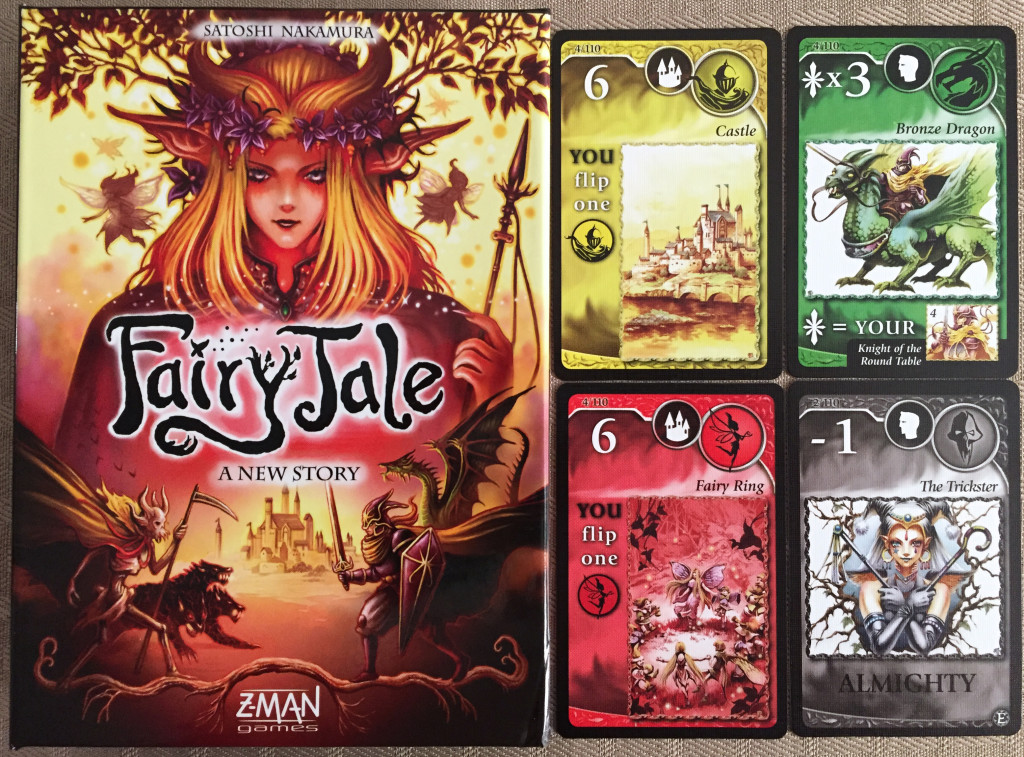“Fairy Tale” has quite the history, having been around for over five years now. After giving it a fair shake I can see why, though I’ll get to that in my review. “Fairy Tale” is a challenging draft/set collecting card game that is simple to play but hard to master (at least, in my experience). It’s a non-collectable kind of game, meaning everything you’ll need to play is right in the box without having to buy more cards. For the record, the version I bought was the second edition by Z-Man Games. There’s an Amazon link below for those who want to check it out.
Editor’s Note: The game supports 2-4 players when using the basic rules (in which some cards are removed). The expanded rules (which uses all the cards) supports 2-5 players.
Components
The game includes 110 cards and a rulebook.
Setup & Gameplay
Players will decide if they’ll use the basic or expert rules. If using the basic, then all of the cards with an “E” icon are removed from play. The cards are shuffled and acts as a draw pile.
The game is played over four rounds/drafts. Each round consists of drafting cards, then playing cards.
Drafting
1. Each player receives five cards from the draw pile to form their hand.
2. Each player chooses a card and places it face down in front of them.
3. Each player gives their remaining hand to the next player. In the first and third rounds, cards are passed clockwise. In the second and fourth rounds, the cards are passed counter-clockwise.
4. This is repeated until all players have five face down cards in front of them.
Playing
1. Out of the five cards in front of them, players will choose three to keep and then discard the other two.
2. Each player chooses a card and places it face down in front of them. They are flipped face up simultaneously.
3. Effects are applied in this order: Hunt – Unflip – Flip – Draw.
At the end of the first round, each player will have three cards in front of them (face up or face down). At the end of each subsequent round, three more cards will be in front of them for a total of twelve after the fourth and final round is over.
Players calculate their scores based on the cards face up in front of them and whoever has the most, wins!
Editor’s Note: The above doesn’t cover all of the rules found in the manual, but should give you an idea as to how the game is played.
The Review
Make no mistake, this game can be quite challenging to play despite how easily the game flows. I know it seems hard to believe…after all, you’re really just drafting cards, choosing three, and playing them in front of you. It’s the cards themselves that really made my head spin…particularly their synergy and how they mesh with other cards. I took forever during the drafting process because I got so caught up in the probabilities and what other players might take once I passed the hand off. It can really be hard sometimes to make a choice between three really good cards, knowing you’d never be able to play all of them. As such, I want to point out that it’s OK if you don’t get this game right away. It’ll take some time to learn how all of the cards work together…this game is deceptively simple that way.
I’m personally not ashamed to say that I had a hard time with this one. The amount of information on the cards caused sensory overload, especially when trying to calculate points based on multiple possible scenarios. Some cards don’t have a point value…rather, their value is determined by other cards with which they’re paired. In the first few games, I gave up trying to pay attention to what my opponent was doing and just concentrated on getting the most out of my own cards. I still do that on occasion depending on my mood, knowing full well that my opponent could mess up my plans if I don’t pay attention to the cards we’re passing back and forth. For example, a card he/she plays might flip one of mine face down, making it worth nothing at the end of the game if I don’t flip it back in time.
A casual game this is not. It looks casual, but there’s so much more going on behind the scenes (especially with the expert rules) that I couldn’t recommend it to casual gamers. Yes, you could just play cards without thinking about it, but good luck beating an opponent who is paying attention. Gamers who enjoy a light to moderate strategic scene may enjoy this one, especially if they play a lot of set collecting games already. Folks who don’t may want to start with “Sushi Go!“, which is much simpler and fun to play. From a review standpoint, I found very little wrong with this title and feel that the $15-$20 is more than fair for the amount of replayability offered here.
Final Verdict: 8/10
—

